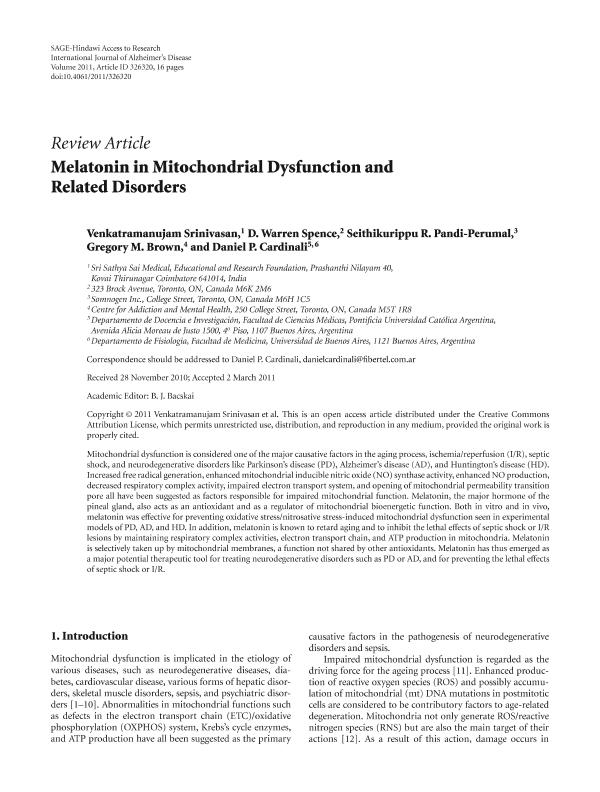Mostrar el registro sencillo del ítem
dc.contributor.author
Srinivasan, Venkatramanujam
dc.contributor.author
Spence, David Warren

dc.contributor.author
Pandi Perumal, Seithikurippu R.

dc.contributor.author
Brown, Gregory M.

dc.contributor.author
Cardinali, Daniel Pedro

dc.date.available
2023-03-29T16:08:09Z
dc.date.issued
2011-03
dc.identifier.citation
Srinivasan, Venkatramanujam; Spence, David Warren; Pandi Perumal, Seithikurippu R.; Brown, Gregory M.; Cardinali, Daniel Pedro; Melatonin in mitochondrial dysfunction and related disorders; Hindawi Publishing Corporation; International Journal of Alzheimer's Disease; 2011; 3-2011; 1-16
dc.identifier.issn
2090-0252
dc.identifier.uri
http://hdl.handle.net/11336/192058
dc.description.abstract
Mitochondrial dysfunction is considered one of the major causative factors in the aging process, ischemia/reperfusion (I/R), septic shock, and neurodegenerative disorders like Parkinson's disease (PD), Alzheimer's disease (AD), and Huntington's disease (HD). Increased free radical generation, enhanced mitochondrial inducible nitric oxide (NO) synthase activity, enhanced NO production, decreased respiratory complex activity, impaired electron transport system, and opening of mitochondrial permeability transition pore all have been suggested as factors responsible for impaired mitochondrial function. Melatonin, the major hormone of the pineal gland, also acts as an antioxidant and as a regulator of mitochondrial bioenergetic function. Both in vitro and in vivo, melatonin was effective for preventing oxidative stress/nitrosative stress-induced mitochondrial dysfunction seen in experimental models of PD, AD, and HD. In addition, melatonin is known to retard aging and to inhibit the lethal effects of septic shock or I/R lesions by maintaining respiratory complex activities, electron transport chain, and ATP production in mitochondria. Melatonin is selectively taken up by mitochondrial membranes, a function not shared by other antioxidants. Melatonin has thus emerged as a major potential therapeutic tool for treating neurodegenerative disorders such as PD or AD, and for preventing the lethal effects of septic shock or I/R.
dc.format
application/pdf
dc.language.iso
eng
dc.publisher
Hindawi Publishing Corporation

dc.rights
info:eu-repo/semantics/openAccess
dc.rights.uri
https://creativecommons.org/licenses/by-nc-sa/2.5/ar/
dc.subject
MITOCHONDRIAL DYSFUNCTION
dc.subject
AGING
dc.subject
ALZHEIMER´S DISEASE
dc.subject
MELATONIN
dc.subject.classification
Fisiología

dc.subject.classification
Medicina Básica

dc.subject.classification
CIENCIAS MÉDICAS Y DE LA SALUD

dc.title
Melatonin in mitochondrial dysfunction and related disorders
dc.type
info:eu-repo/semantics/article
dc.type
info:ar-repo/semantics/artículo
dc.type
info:eu-repo/semantics/publishedVersion
dc.date.updated
2023-03-28T14:20:14Z
dc.journal.volume
2011
dc.journal.pagination
1-16
dc.journal.pais
Estados Unidos

dc.description.fil
Fil: Srinivasan, Venkatramanujam. No especifíca;
dc.description.fil
Fil: Spence, David Warren. No especifíca;
dc.description.fil
Fil: Pandi Perumal, Seithikurippu R.. No especifíca;
dc.description.fil
Fil: Brown, Gregory M.. No especifíca;
dc.description.fil
Fil: Cardinali, Daniel Pedro. Universidad de Buenos Aires; Argentina. Pontificia Universidad Católica Argentina "Santa María de los Buenos Aires"; Argentina. Consejo Nacional de Investigaciones Científicas y Técnicas; Argentina
dc.journal.title
International Journal of Alzheimer's Disease
dc.relation.alternativeid
info:eu-repo/semantics/altIdentifier/doi/http://dx.doi.org/10.4061/2011/326320
Archivos asociados
